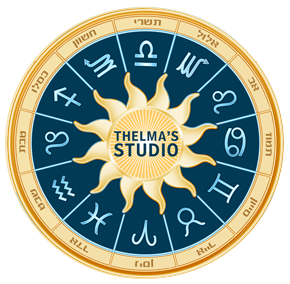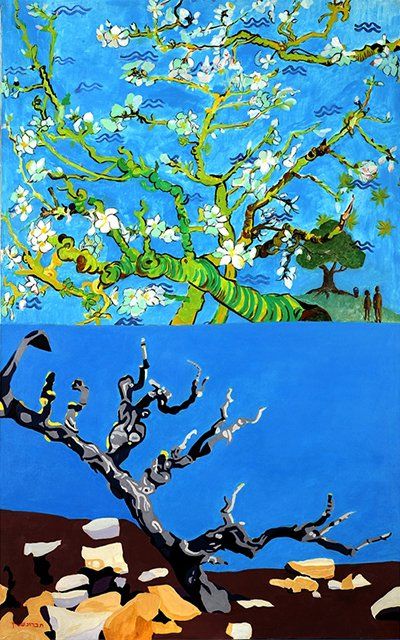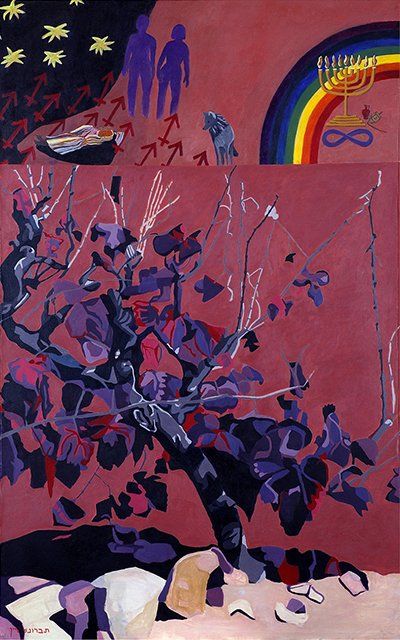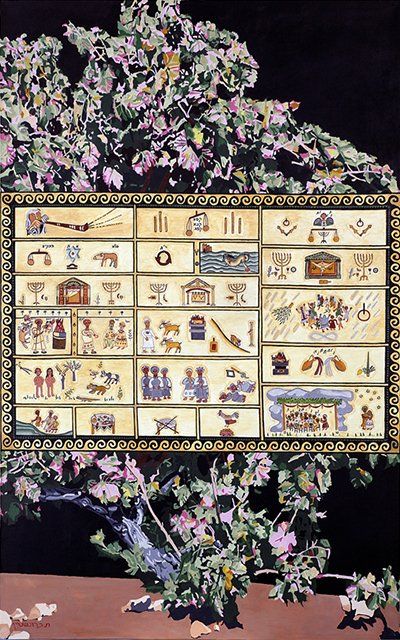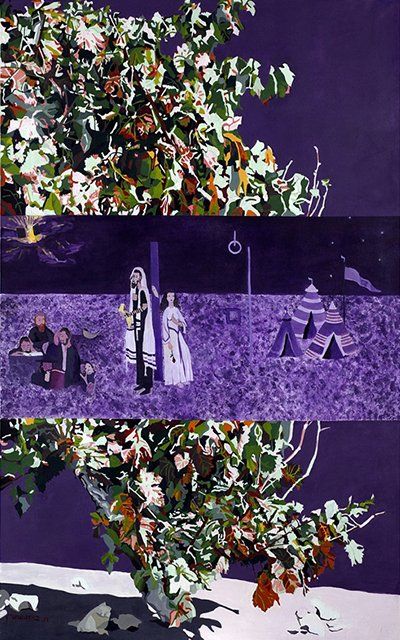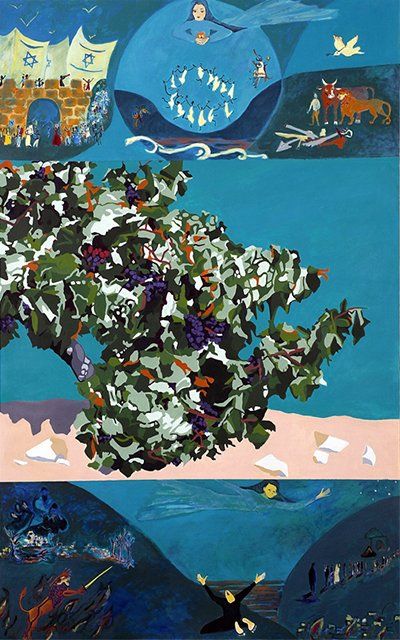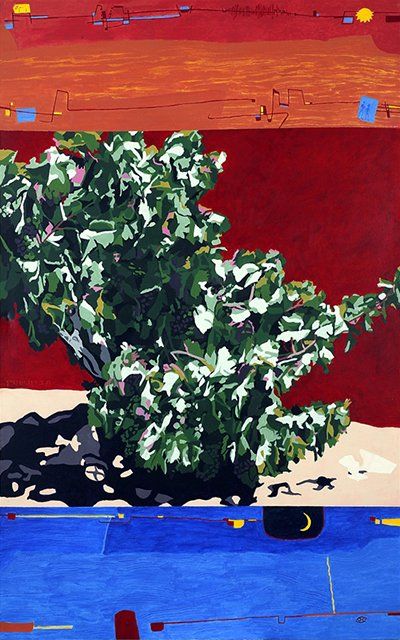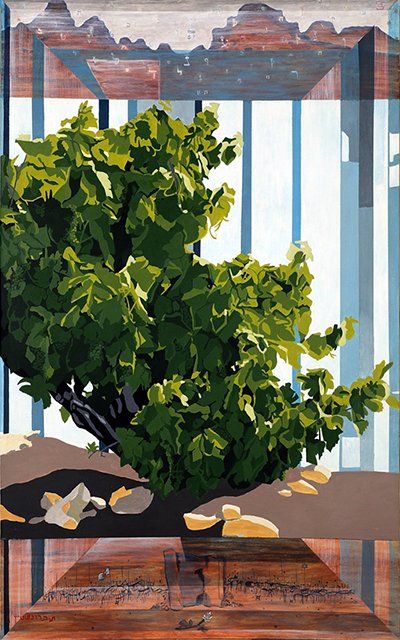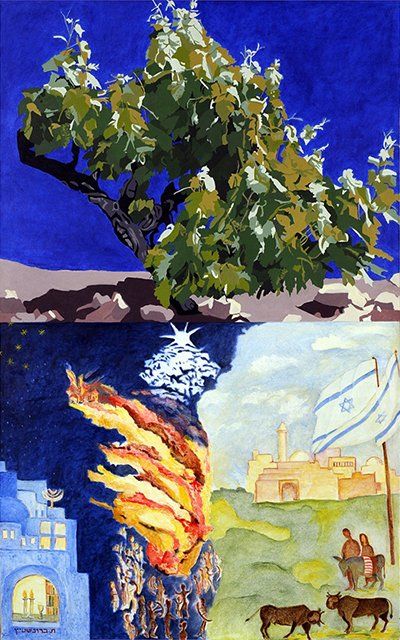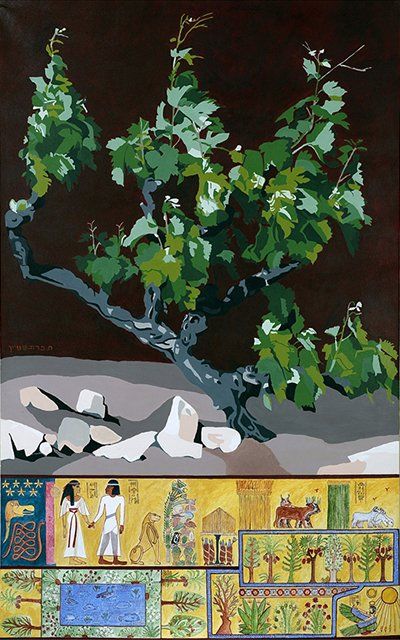מיצג "מסע השנה היהודי"
המיצג "מסע השנה היהודי" בא כדי לענות על רצון להבין וניסיון להסביר את הקשר של הפרט למסורת רבת שנים שאינה מוכרת כל כך לרבים, בציור. בציור יש חשיבות לנראה לעין, לנגלה כביכול, בלי שימוש בחושים אחרים כדי ליצור חוויה רגשית, אסטטית ואינטלקטואלית. עבודה כזו לא נעשתה (לפי דעתי) בעבר בגלל מסורת רבת שנים של "לא תעשה לך תמונה" שמנעה ביטוי חזותי חופשי. ואם נעשה ביטוי שכזה הוא היה בדרך כלל מגמתי-פרשני לכתובים. עבודה זו נמנית על מסורת עתיקה זו הקיימת כמה אלפי שנים וביטויה הראשון היה במעשי בצלאל בעבודת המשכן וארון הקודש.
הבחירה בחודשים-מזלות נבע מחיפוש אחרי נושא שיגע ביסודות העמוקים ביותר של היהדות ואין דבר הממחיש זאת טוב יותר מלוח השנה היהודי. "שנה" היא מילה נרדפת ל"חזור" – מהות הזמן היהודי, זמן מעגלי מנותק ומחובר לזמן הכללי ומכיוון שכך יש אפשרות לכל פרט ופרט לתקן את עצמו ולסייע בתיקון העולם. נושא הזמן הוא מוחשי ובלתי מוחשי בו זמנית. אובייקטיבי וסובייקטיבי וכל יצור עלי אדמות פועל על פיו בידיעה או שלא בידיעה.
12 החודשים הם ביטוי לכוח ומלכות האלוהים בבריאה כולה ולאין סופיותו. דבר המתבטא גם ב-12 השבטים המקובעים ב-12 אבני החושן. גלגל המזלות קשור להבטחה שניתנה לאברהם בהר המוריה לבין העתיד – בניית המקדש והגאולה.
בכוחו של נותן ההבטחה להוציא אותה בסופו של דבר לפועל. פירוש זה נכון לפסיפסי גלגל המזלות בבתי הכנסת מהמאות הראשונות לספירה. הקשר בין המזלות ועם ישראל מוצא את ביטויו החזק ביותר בתורה ובפרשות השבוע שזורקות אור על משמעויות החודש. רבי שמשון רפאל הירש העיר שעיקרי האמונה היהודית כתובים על דפי הלוח העברי, תוך מיזוג שנת החמה לחודשי הירח, בהתייחסות לעונות השנה, מערכת החגים, המועדים ,ימי הזיכרון וסתם ימי חול.
התמונות הן בגודל 160X100 ס"מ כדי שהצופה "יכנס" לתמונה ויתרכז רק בה ב-"עכשיו" של התמונה בלי שהעין תפזול לצדדים. אי אפשר לראותן יחד בבת אחת. כשם שאנחנו נמצאים ברגע הזה, הנוכחי כך אנחנו במזל הזה עם השפעותיו עלינו. כל אחד יכול להבין ולפרש את הזמן המסוים על פי גילו, תחושתו, הבנתו וידיעותיו. מכאן פרוש התמונה יכול להתפרש כמו הנכנס לפרדס.
המסע עוקב אחרי מעגלי השנה ואין הסיבוב הראשון כסיבובים הבאים אחריו, כמו שאין שנה דומה לאחרת למרות הזמנים הקבועים.
6 תמונות מחולקות ל-2 ו-6 ל-3 ואין תמונה דומה לחברתה. הדבר המאחד את כולן הוא הגפן. היא מצוירת בסגנון אחיד ובאופן טכני לחלוטין לפי מצב הגפן בכרם באותו חודש. הבחירה בגפן אינה מקרית. הגפן היא נציג הטבע. עם ישראל משול להרבה דברים ביניהם צמחים שונים, אך הצמח המסמל ומייצג ביותר את מהותו היא הגפן. הגפן לכשלעצמה היא יציר האל, אך היין, מעשה האדם, טומנת בחובה משמעויות רבות. הוא התגלות הדבר שנטמן בענבים ונשתנה למעלות לקבוע ברכה.
הוא מייצג בחירה חופשית בין טוב ורע, בחירה במידה, משמש לקידוש בשבת וחגים ולהבדלה בין קודש לחול, חייב להעשות על ידי ישראל בלבד אחרת פסול, מסמל ייחוד, קדושה וברכה וכן תשובה, בינה ושמחה בסוד היין. כן ענווה בגלל קומת הגפן, הנשרכת על האדמה. יש גם פן אישי בבחירת הגפן – שם משפחת אמי ויינשטיין, אני נשואה לכורם וגרה בזכרון יעקב.
החלק השני של התמונות מתייחס לחודש עצמו וכאן יש התייחסות לשבט באמצעות סמלו, אבן החושן שעליו חרוט שם השבט והחודש. ואל יהא הדבר פשוט בעיניכם מאחר והקשר בין השבט לאבן החושן מוזכר בתורה, אך אין יודעים היום בדיוק איזו אבן היא האבן הנזכרת בתורה ויש פרושים שונים מחז"ל וגמלוגים. מכאן שצבע האבן לא כל כך ברור, וכן הקשר בין המזלות לשבטים. יש לפחות ארבע גרסאות שונות על פי חז"ל והייתי חייבת לבחור גרסה אחת ולהתאים צבע תוך הסתמכות על צבעי הדגלים המוזכרים במקורות.
בחלק זה הסגנון של כל תמונה שונה לגמרי ויש ציטוטים מעבודות גדולים ממני מהתקופה המצרית, בבלית עד התקופה המודרנית, ביניהם אמנים יהודים מהמאה הראשונה לפני הספירה עד ימינו. הבחירה בסגנונות השונים נעשתה מתוך ניסיון להגיע קרוב ככל האפשר למהות ומשמעויות החודש המסוים כפי שהבנתי אותן ללא כל ניסיון ליצור סגנון אישי מתוך רצון לפשט את הדברים מבחינה חזותית ככל האפשר. מכאן הציור הפיגורטיבי ברובו.
לכל ציור מתלווה הסבר כתוב בצורת "דף גמרא" מאחר והרבה דברים המובאים אינם מוכרים וידועים לרבים.
INTRODUCTION
The work "The Jewish Annual Trip" tries to fulfill the desire to understand and is an attempt to explain the connection of the individual to a long tradition that is not known to many in painting. In painting what is important is what is seen, the apparent, without using other senses to create an emotional, esthetic and intellectual experience.
A work of this kind (to my knowledge) was never performed in the past because of a long tradition of "Thou shall not make a picture" that prevented free visual expression. And if it was expressed it was usually orientated and explanatory to the Scriptures. This work is part of this ancient tradition of a few thousand years and its first manifestation was in the work of Bezalel in the Tabernacle and the Holy Ark.
The choice of the months – constellations stemmed from a search for a subject that reaches he deepest foundations of Judaism and nothing realizes this better than the Jewish calendar. Year =:Shannah" is a synonym to 'repeat'- the essence of Jewish time, a rotating time detached and attached to the general time and therefore each and every individual can amend himself and contribute to the amendment of the world. The issue of time is, at the same time, concrete and abstract, objective and subjective and each creature on earth acts according to it knowingly or unknowingly.
The twelve months are an expression of the Divine Power and Kingdom in the entire creation and of His infinity. This is also expressed in the twelve tribes engraved in the twelve breastplate stones. The zodiac is connected to the promise given to Abraham on Mount Moriah and the future – the construction of the Temple and Salvation. It is in the power of the Promise Giver to eventually fulfill it. This interpretation is to be given to the zodiac mosaics in the synagogues from the first centuries A.D.
The bond between the months and the people of Israel finds its strongest expression in the Torah and the weekly portions that illuminate the meanings of the month. Rabbi Shimshon Raphael Hirsch commented that the principles of the Jewish faith are written on the Pages of the Jewish Calender , combining the solar year to the lunar months, referring to the seasons of the year, the system of holidays, commemoration and simple secular days.
The pictures are 1.6m by 1m, to enable the spectator "to enter" the painting and concentrate on the "now" without letting the eyes stray aside. One can understand, interpret the specific time according to one's age, feeling, understanding and knowledge. Thus the interpretation can be compared to entering the "Pardess". The trip follows the year circles, and the first round is unlike the following ones, exactly as no year resembles the other despite the fixed times.
Six pictures are divided into two and six into three and no picture is like the other. The thing in common to them all is the Vine. It is painted in one completely technical style according to the state of the vine in the vineyard that month. The choice of the vine is not incidental. The vine is Nature's representative. The people of Israel are compared to many things among them plants, but the plant that most symbolizes and represents their essence is the vine The vine, itself, is a creation of God, but the wine, is man made, hints at many meanings. It is the revelation of what is hidden in the grapes and transformed to heights to fix blessing. It represents free choice between good and bad, measured choice, used for sanctification of the Sabbath and holidays and for differentiation between holy and secular. It has to be made by Israel only, otherwise it is disqualified, symbolizing union, holiness, blessing and repentance, Insight and joy , all in the secret of wine. Modesty too, because of the height of the vine which crawls on the ground.
There is also a personal side in choosing the vine: my mother's maiden name was Weinstein, I am married to a vine grower and live in Zichron Yaakov.
The second part of the pictures refer to the month itself and here the reference to the tribe through its emblem, the breastplate stone on which the tribes' names are inscribed and the month. The last connection is problematic because the connection between the tribe and stone is mentioned in the Bible, but today no one knows exactly which stone is the one mentioned and there are different explanations of the Sages and gemologists, so the colour of the stone is not so obvious and so isn't the connection between the months and the tribes. There are at least four versions according to the Sages and I had to choose one and match the colours, relying on the colours of the flags mentioned in the Torah. In this part, the style of each painting is completely different and there are quotations from works of greater artists than myself from the Egyptians, Babylonians to our times, among them Jewish artists from the first century A.D. till today. The choice of the different styles was based on the effort to reach the essence and meanings of the specific month as close as possible, as I understood them, without trying to create a personal style and because of the desire to simplify the ideas as much as possible from the visual aspect. Thus the painting is mostly figurative.
Each painting has notes attached because a lot of the things presented are not familiar and known to many.
Thelma Bronstein.

